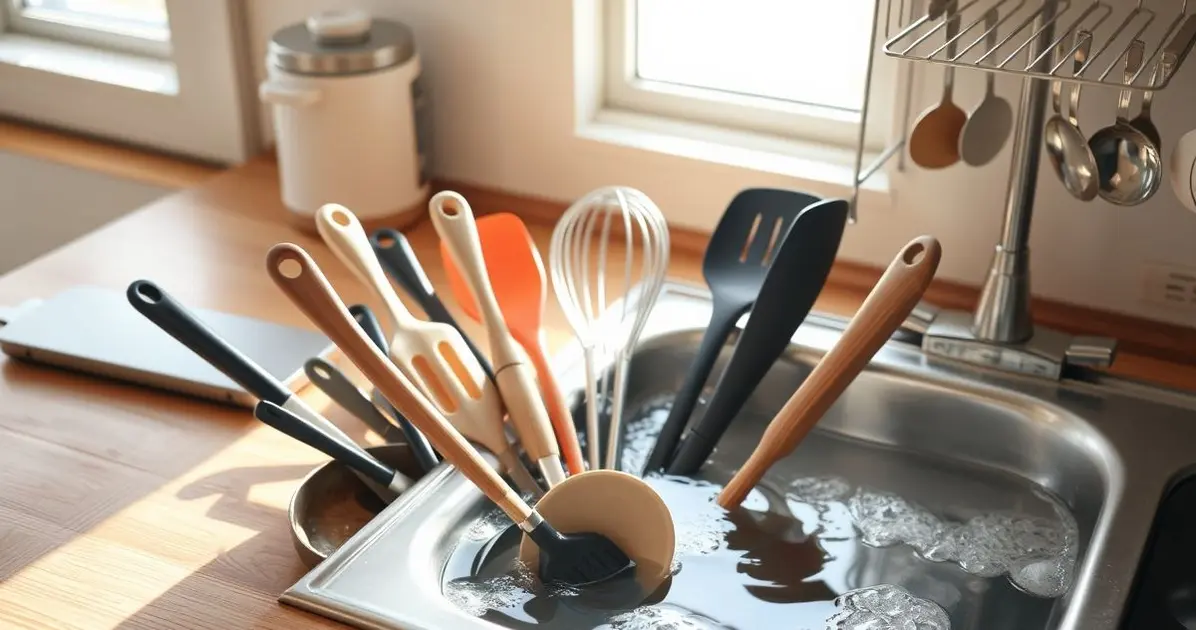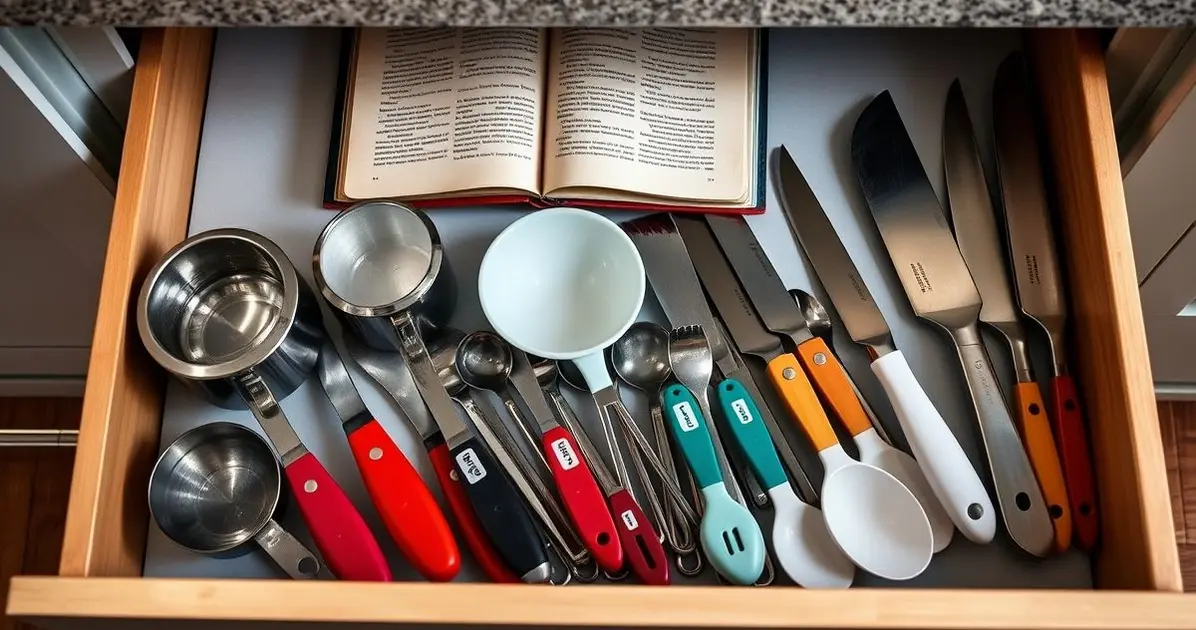Cleaning and storing your cooking tools and equipment is essential for maintaining a hygienic kitchen. Regular care ensures that utensils are in good condition, ready for use at a moment’s notice.
How to clean and store cooking tools and equipment utensils

Properly cleaning and storing kitchen utensils extends their life and promotes food safety. Make sure to wash items with warm, soapy water, dry them thoroughly, and organize them in designated areas to create an efficient cooking environment.
Step-by-Step Instructions for Cleaning Utensils
Cleaning your utensils properly is essential for maintaining hygiene and ensuring they last longer. Here are the step-by-step instructions for cleaning utensils effectively.
1. Gather Your Cleaning Supplies: Before you start, make sure you have the following items ready:
- Mild dish soap
- Warm water
- Non-abrasive sponge or cloth
- Baking soda (for tough stains)
- Vinegar (for disinfecting)
2. Rinse Immediately: After using your utensils, rinse them under warm water to remove any food particles. This prevents residue from hardening and makes cleaning easier.
3. Prepare a Cleaning Solution: In a bowl or sink, mix warm water with a few drops of mild dish soap to create a soapy solution. This will be used to wash your utensils.
4. Wash the Utensils: Dip a non-abrasive sponge or cloth into the soapy water and scrub the utensils gently. Pay special attention to any areas with stuck-on food or grease. For wooden utensils, use a damp cloth instead of soaking them to avoid warping.
5. Use Baking Soda for Stubborn Stains: If you encounter tough stains or odors, sprinkle baking soda on the stained area and scrub gently with the sponge. Baking soda acts as a natural abrasive and deodorizer.
6. Rinse Thoroughly: After cleaning, rinse each utensil under warm running water to remove all soap and cleaning agents. Ensure there are no residues left behind, as this can affect the taste of your food.
7. Disinfect (Optional): For added hygiene, especially after handling raw meats, you can disinfect your utensils by wiping them with a solution of equal parts vinegar and water. Allow the solution to sit for a few minutes before rinsing again.
8. Dry Completely: After rinsing, dry your utensils thoroughly with a clean towel or let them air dry completely. Ensuring they are dry prevents moisture buildup, which can lead to rust or mold.
9. Store Properly: Once dry, store your utensils in an organized manner. Use drawer organizers or utensil holders to keep them sorted and easily accessible.
By following these step-by-step instructions, you can ensure that your utensils are clean, hygienic, and ready for your next cooking adventure. Regular cleaning not only maintains hygiene but also enhances the longevity of your cooking tools!
Importance of Appropriate Cleaning Agents and Techniques
The importance of appropriate cleaning agents and techniques in maintaining your kitchen tools and equipment cannot be overstated. Using the right cleaning solutions and methods ensures that your cooking utensils remain safe, hygienic, and in good condition. Here are some key reasons why this is crucial:
1. Ensures Food Safety: Using food-safe cleaning agents is essential for preventing contamination. Chemicals that are not meant for food contact can leave harmful residues on utensils and surfaces, posing health risks. Appropriate cleaning agents ensure that your tools are safe for food preparation.
2. Effectiveness Against Bacteria: Not all cleaning agents are created equal. Some are specifically formulated to kill bacteria and viruses, making them essential for sanitizing kitchen tools, especially after handling raw meats. Using the right agents helps maintain a hygienic cooking environment.
3. Preserves Material Integrity: Different materials require specific cleaning techniques to avoid damage. For example, abrasive cleaners can scratch non-stick surfaces or dull the edges of knives. By using appropriate cleaning methods, you can preserve the integrity of your utensils and prolong their lifespan.
4. Reduces Allergens and Irritants: Certain cleaning agents may contain allergens or irritants that can affect sensitive individuals. Choosing natural and hypoallergenic cleaning solutions minimizes the risk of allergic reactions and creates a safer cooking environment.
5. Enhances Cleaning Efficiency: The right cleaning agents can make the cleaning process more efficient. For instance, natural solutions like vinegar and baking soda can effectively break down grease and stains, reducing the time and effort required for cleaning.
6. Environmental Considerations: Using eco-friendly cleaning agents contributes to a healthier environment. Many natural cleaning solutions are biodegradable and free from harmful chemicals, making them a sustainable choice for your kitchen.
7. Improves Overall Kitchen Hygiene: Appropriate cleaning techniques, such as using the correct method for different materials, ensure that all areas of your kitchen are kept clean and free from contaminants. This contributes to a hygienic cooking space, which is vital for food safety.
In summary, the importance of using appropriate cleaning agents and techniques in your kitchen cannot be overlooked. By ensuring that you use the right products and methods, you promote food safety, preserve your cooking tools, and maintain a clean and efficient kitchen environment. This attention to detail enhances your overall cooking experience and contributes to better meal preparation.

Efficient Kitchen Organization with Smart Storage Solutions
Efficient kitchen organization is essential for creating a functional and enjoyable cooking environment. Implementing smart storage solutions can help maximize space, improve accessibility, and keep your kitchen tidy. Here are some effective strategies for organizing your kitchen:
1. Utilize Vertical Space: Make the most of your kitchen’s vertical space by installing shelves or cabinets that reach up to the ceiling. Use the upper shelves for items that are used less frequently, while keeping everyday essentials within easy reach.
2. Drawer Organizers: Invest in drawer organizers to keep utensils, cutlery, and small tools neatly arranged. These dividers prevent clutter and make it easier to find what you need quickly when cooking.
3. Magnetic Strips: Install magnetic strips on walls to hold knives and metal utensils. This not only saves drawer space but also keeps these tools visible and easily accessible.
4. Hanging Racks: Use hanging racks or pot racks to store pots and pans. This method frees up cabinet space and allows you to display your cookware as part of your kitchen decor.
5. Clear Storage Containers: Store dry ingredients like flour, sugar, and pasta in clear, labeled containers. This not only keeps your pantry organized but also makes it easy to see when supplies are running low.
6. Lazy Susans: Incorporate lazy Susans in cabinets or on countertops to easily access spices, condiments, or other small items. This rotating storage solution maximizes space and minimizes the need to reach into the back of cabinets.
7. Under-Sink Storage: Use tiered organizers or pull-out bins under the sink to store cleaning supplies and dish soap. This area is often underutilized, and effective organization can keep it tidy and functional.
8. Label Everything: Label storage containers, shelves, and drawers to make it easy for everyone in the household to find and return items to their proper places. This simple practice helps maintain organization and reduces clutter.
9. Utilize Cabinet Door Space: Hang hooks or small racks on the inside of cabinet doors to store measuring spoons, pot lids, or spices. This clever use of space keeps items organized and frees up valuable shelf space.
In summary, implementing smart storage solutions can significantly enhance the organization and efficiency of your kitchen. By making the most of your available space and keeping everything easily accessible, you can create a more enjoyable cooking environment that inspires creativity and efficiency in meal preparation.
Tips for Keeping Your Kitchen Sparkling Clean and Functional
Maintaining a sparkling clean and functional kitchen is essential for a pleasant cooking experience. Here are some practical tips to help you keep your kitchen in top shape:
1. Establish a Daily Cleaning Routine: Make it a habit to clean your kitchen daily. Wipe down surfaces, wash dishes, and sweep the floor every day to prevent dirt and grime from building up.
2. Clean as You Go: While cooking, clean up spills and wash utensils as you use them. This practice minimizes mess and makes post-cooking cleanup easier.
3. Use the Right Cleaning Supplies: Invest in quality cleaning supplies that are safe for food contact surfaces. Choose eco-friendly and non-toxic cleaners to ensure a safe cooking environment.
4. Organize Your Tools: Keep your cooking tools organized and easily accessible. Use drawer organizers, magnetic strips, and hanging racks to store utensils and cookware efficiently.
5. Regularly Declutter: Periodically go through your kitchen items and remove anything that you no longer use or need. Donate or dispose of items to keep your kitchen clutter-free.
6. Deep Clean Weekly: Set aside time each week for a deep cleaning session. This should include scrubbing floors, cleaning appliances, and disinfecting surfaces to eliminate bacteria.
7. Pay Attention to High-Touch Areas: Frequently sanitize high-touch areas such as cabinet handles, light switches, and countertops to reduce the spread of germs.
8. Keep Cleaning Tools Handy: Store cleaning supplies in a convenient location so they are easily accessible when needed. Having your cleaning tools within reach encourages regular maintenance.
9. Use Natural Deodorizers: To keep your kitchen smelling fresh, use natural deodorizers like baking soda or essential oils. Place an open box of baking soda in the fridge or use a diffuser with your favorite essential oil.
10. Involve Everyone: If you share your kitchen space with family or housemates, involve everyone in the cleaning process. Assign specific tasks to each person to ensure that the kitchen remains clean and functional.
By following these tips for keeping your kitchen sparkling clean and functional, you can create an inviting cooking environment that enhances your culinary experience. A clean kitchen not only promotes food safety but also makes cooking more enjoyable!
Conclusion
In conclusion, maintaining a clean and organized kitchen is essential for both food safety and culinary success. By implementing effective cleaning techniques, utilizing safe and natural cleaning agents, and establishing smart storage solutions, you can create a functional cooking environment that enhances your cooking experience.
Regular cleaning and proper storage of your cooking tools and equipment not only prolong their lifespan but also promote hygiene, ensuring that your kitchen remains a safe space for food preparation.
Additionally, by following tips for keeping your kitchen sparkling clean and functional, you can enjoy a more pleasant and efficient cooking experience.
Embrace these practices to transform your kitchen into a well-organized and inviting space, making cooking a joyful and rewarding activity for you and your family. With a little effort and commitment to cleanliness, your kitchen can be a shining example of efficiency and hygiene!
FAQ – Frequently Asked Questions about Cleaning and Storing Cooking Tools
Bakit mahalaga ang tamang paglilinis ng mga kagamitan sa pagluluto?
Mahalaga ang tamang paglilinis upang mapanatili ang kaligtasan ng pagkain, maiwasan ang bakterya, at pahabain ang buhay ng mga kagamitan.
Ano ang mga ligtas at natural na paraan ng paglilinis ng mga cooking tools?
Ang mga ligtas at natural na paraan ay kinabibilangan ng paggamit ng suka, baking soda, at lemon juice bilang mga disinfectant at cleaning agents.
Paano dapat itago ang mga kutsilyo at kawali?
Dapat itago ang mga kutsilyo sa knife block o magnetic strip at ang mga kawali sa isang maayos na paraan, gamit ang mga separator o liners.
Gaano kadalas dapat linisin ang mga kagamitan sa pagluluto?
Dapat linisin ang mga kagamitan pagkatapos gamitin, at isagawa ang mas malalim na paglilinis nang lingguhan at buwanan.
Ano ang mga tips para sa tamang pag-iimbak ng mga cooking tools?
Siguraduhing tuyo ang mga kagamitan bago itago, gumamit ng tamang storage solutions, at regular na suriin ang mga ito para sa wear and tear.
Paano ko mapapanatiling malinis at maayos ang aking kusina?
Magsagawa ng regular na paglilinis, gumamit ng mga ligtas na cleaning agents, at sanayin ang lahat ng staff sa tamang mga pamamaraan ng paglilinis.
See more
Discover plenty of easy and delicious recipes you can make at home, from hearty dinners to indulgent desserts and wholesome breakfasts.




